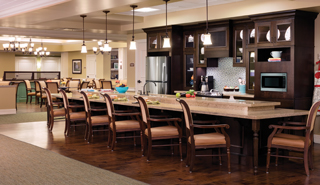
The era of “warehousing” long-term care residents with Alzheimer’s and dementia is, thankfully, fading into the past. Progressive thinking about how design and compassionate care complement each other is leading to new structures that are integral and visible in long-term care properties, instead of being segregated.
One example of the new model is Brookdale Roswell, in Roswell, GA, which has embraced Clare Bridge Memory Care. This concept allows residents to transition seamlessly from one segment of care to another. The new $7.9 million memory care community, which opened in March 2016, is part of a senior living campus that includes independent and assisted living, but also has convertibility to skilled nursing.
The approximately 26,000-square-foot structure has 32 beds and is dedicated to memory support for residents from all segments of Brookdale’s community. David Minnigan, head of senior living design for ESa, a Nashville-based architecture firm, says in recent years his firm has focused on freestanding memory care as “a more specific product in the senior living continuum … designed from scratch and intentionally created for the needs of this group.”
While there is no skilled nursing currently on campus, the center is designed so that the infrastructure can be converted to serve residents with those needs. Exit doors, fire codes and building dimensions have been designed to SNF standards. The transitionability aspect is important, Minnigan says, because “our clients want the ability to convert to skilled nursing if the situation warrants it.”
Jay Keopf, senior director of development for Brookdale, says the rationale is clear cut.
“This project broadened the continuum of care to the residents by offering dementia services, providing care for those who need it currently and the assurance that this level of care will be available,” Keopf says.
Life skills stations set up in common areas around the property serve an aesthetic and functional purpose, notes Leslie Ann Wilson, interior designer for ESa. For instance, the laundry area features posters of old detergent advertisements while a folding table provides residents with the opportunity for the therapeutic activity of folding laundry.
“The art relates to the spaces and the activities that happen in those spaces,” Wilson says. “Vintage color photographs give residents a sense of normalcy if they regress into a time from their pasts.”
The new Clare Bridge building is designed to be residential, as opposed to a clinical or healthcare environment. Residents’ medical needs are cared for, Koepf says, “just not in a hospital-like setting.”
In lieu of a nursing station, Brookdale Roswell utilizes a Country Kitchen approach for residents and staff to congregate and interact. Not only does the space work well as a gathering area, residents also can enjoy snacks and meals while they socialize.
From the February 01, 2017 Issue of McKnight's Long-Term Care News




